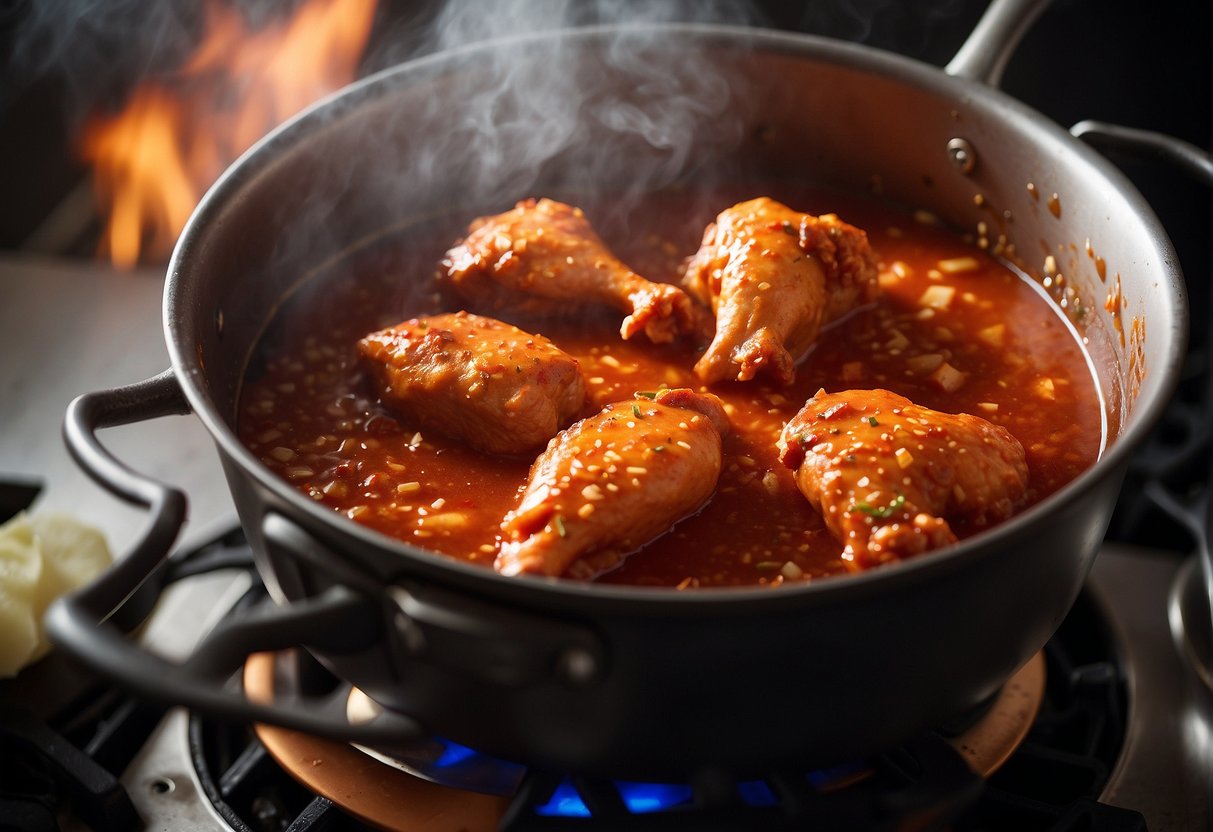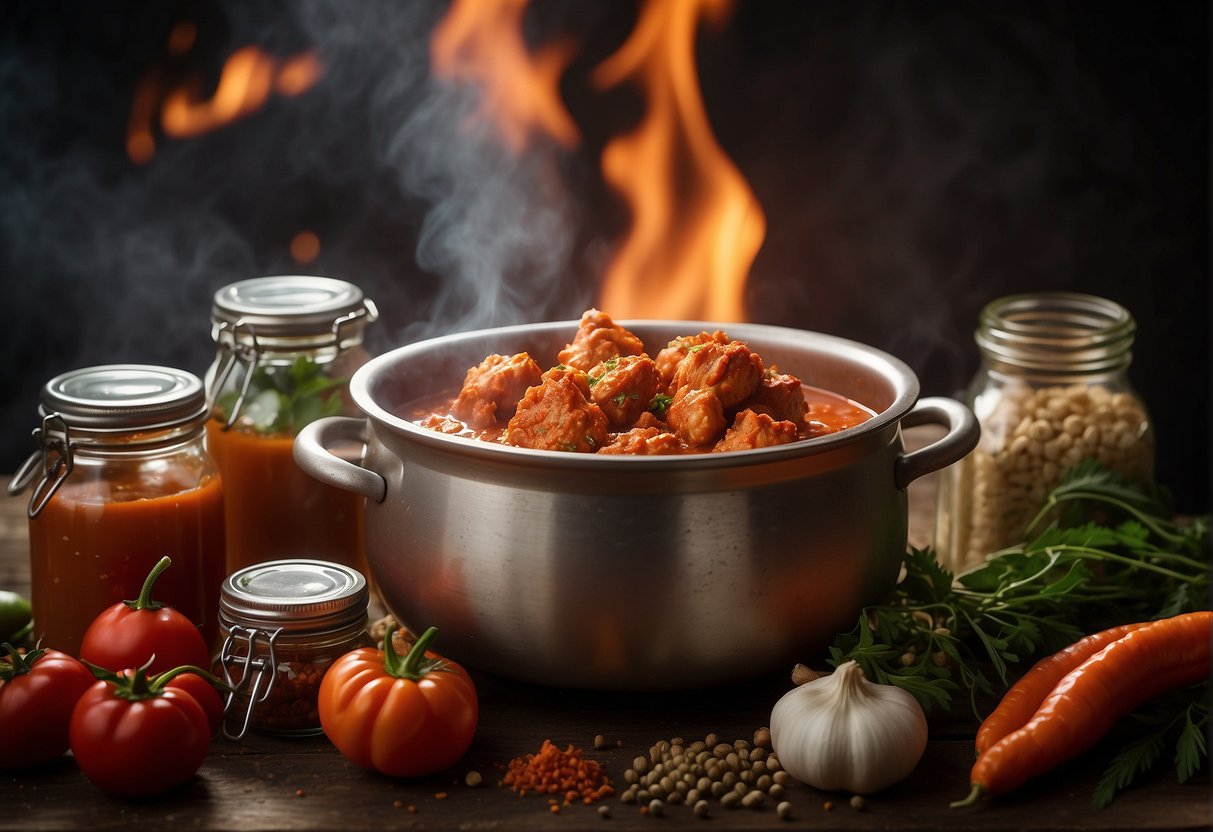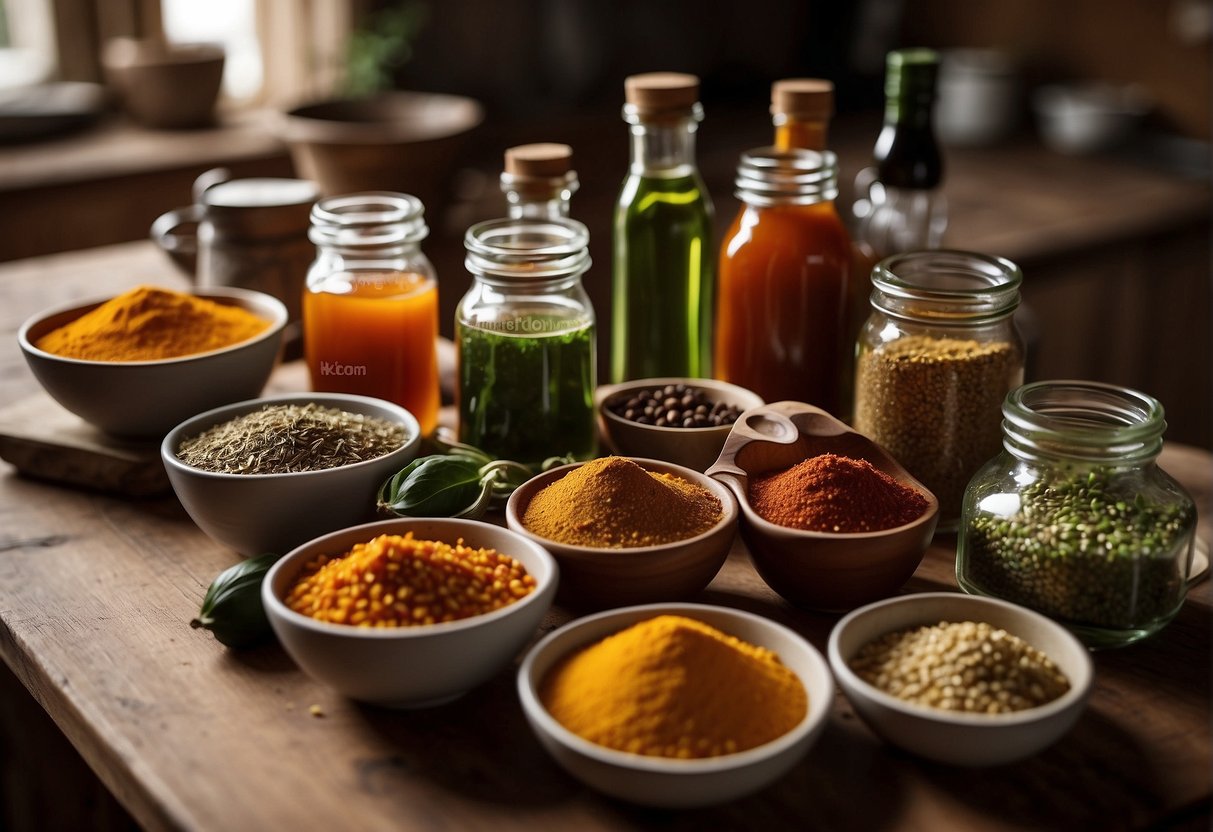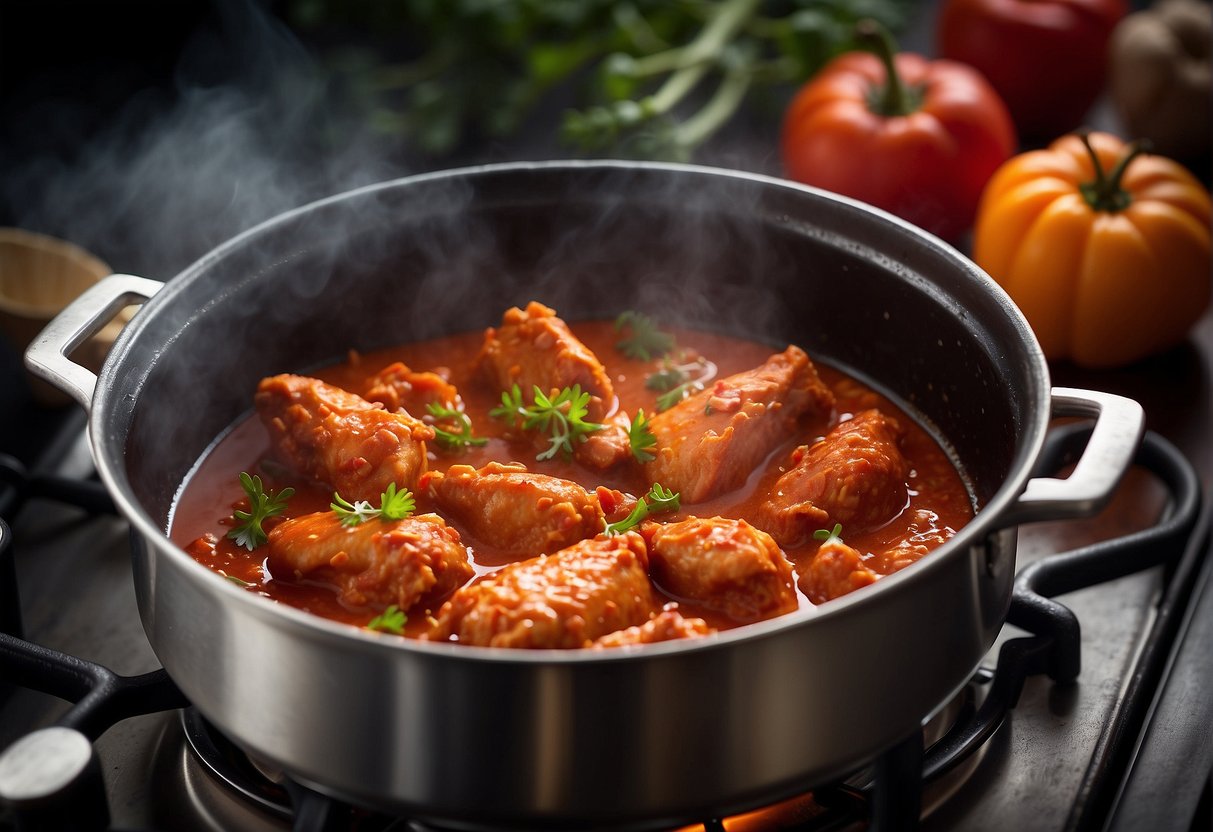When it comes to replicating the fiery kick and creamy blend of Dave’s Hot Chicken Sauce, I pride myself on my ability to create a near-perfect homage to the original. This hot sauce, a culinary sensation inspired by the mouthwatering flavors of Nashville hot chicken, quickly becomes a favorite for anyone who tries it. Its bold blend of heat and tang is what makes it a stand-out condiment for fried chicken, sandwiches, and even fries.

In crafting my version of Dave’s Hot Chicken Sauce at home, I pay close attention to achieving the right balance of flavors. It’s not just about the heat; it’s about complementing the savory notes of the chicken with a sauce that packs a punch without overpowering the palate. The process is surprisingly straightforward, and with just a few ingredients, I can whip up a batch of this cherished hot sauce that rivals the addictive quality of the original.
History and Origin

The story of Dave’s Hot Chicken Sauce is one that closely intertwines with my own appreciation for the Nashville hot chicken recipe. It all started in Nashville, a city revered for its culinary adventures involving spicy fried chicken. The local cuisine here championed a dish that bravely combined fiery heat with deeply satisfying flavors.
In my journey through the world of spicy condiments, I’ve come to understand that Dave’s Sauce wasn’t merely created overnight. It’s a product of careful crafting to complement the iconic Nashville dish. As Nashville hot chicken gained acclaim for its unique blend of heat and taste, the sauce followed suit, capturing the attention of spicy food aficionados everywhere.
By melding ingredients like cayenne pepper for heat, garlic, and onion powders for depth, and a base of smooth mayonnaise, I’ve seen firsthand how this sauce truly makes fried chicken sing. From the streets of Nashville to kitchens worldwide, Dave’s Hot Chicken Sauce has carried its legacy.
Here’s a simple breakdown of what goes into the sauce:
- Heat: Cayenne pepper
- Savory Elements: Garlic powder, onion powder
- Color and Flavor: Paprika
- Smoothness: Mayonnaise
- Acidity: Pickle juice
My admiration for this sauce comes from its ability to strike a balance with these elements, providing just enough kick without overpowering the palate. The sauce’s history is not just about its ingredients, but also about the experience it delivers—transforming a meal into an unforgettable culinary adventure.
Key Ingredients
When I craft Dave’s Hot Chicken Sauce, I focus on a blend of main ingredients that deliver the sauce’s hallmark creamy texture and fiery kick. Here’s a breakdown of what goes into this spicy condiment:
- Cayenne Pepper: The amount of cayenne pepper determines the heat level. I find starting with one teaspoon and then adjusting to taste works well to customize the spice.
- Garlic Powder & Onion Powder: Essential for depth, I use a half teaspoon of garlic powder and onion powder to add a savory undertone.
- Brown Sugar: For that hint of sweetness which balances the heat, about two tablespoons of brown sugar usually suffices to add a subtle sweetness.
- Black Pepper: A robust seasoning, I sprinkle in a quarter teaspoon of black pepper.
- Lime Juice: Freshly squeezed lime juice, about one tablespoon, introduces a refreshing tangy flavor.
- Chili Powder: To amplify the chili profile without overpowering, I like to add a half teaspoon.
These simple ingredients combine to create a sauce that’s complex in flavor yet easy to make. Remember, the key to the perfect hot sauce is balancing the tangy with the sweet, and the spicy with the savory. With these ingredients, I can confidently say that the result is close to Dave’s original sauce’s delicious punch.
Equipment and Preparation

In making Dave’s hot chicken sauce, having the right equipment and following a structured preparation process are crucial. Here, I’ll guide you through the necessary utensils and step-by-step instructions.
Required Utensils
- Medium-sized saucepan: This is essential for combining and heating your sauce ingredients to blend flavors effectively.
- Whisk: A sturdy whisk is vital for ensuring that ingredients emulsify into a smooth sauce.
- Airtight container: To store any leftover sauce and maintain its freshness, an airtight container is the best choice.
Preparation Steps
- Gather Ingredients: Before beginning, I make sure all ingredients are measured and laid out within reach.
- Heat Ingredients: In my medium-sized saucepan, I mix the base ingredients over low heat, just until they’re well incorporated.
- Cooling: After removing the saucepan from the heat, I let the sauce cool to room temperature.
- Transfer: Once cooled, I pour the sauce into an airtight container for storage or ready it for immediate use.
During these steps, I also keep paper towels at hand to promptly deal with any spills or drips, keeping my workspace clean. If a baking sheet is required for any reason, such as heating garnishes, I ensure it’s lined for easy cleanup.
Cooking Technique

When preparing Dave’s Hot Chicken Sauce, I start by evenly coating my carefully selected pieces of fried chicken. The trick here is to maintain a medium heat while frying to achieve that irresistible golden brown crispiness that provides a sturdy base for the sauce to cling to.
Here’s how I ensure a perfect balance of heat in the sauce:
Measure Ingredients Cold:
- Start with cold ingredients to keep the sauce stable. This makes for a creamier texture when combined.
Slowly Stir in Heat:
- I incorporate the spices and seasonings with a gentle hand. Over-stirring can cause the sauce to separate or become too thin.
Balance Flavors:
- Achieving the right heat level is about balance, not just spiciness. I taste as I go, ensuring each element is harmonious.
Rest Before Serving:
- Allowing the sauce to rest after preparation lets the flavors meld together, so it’s not just hot but also deeply savory.
Here are a few additional cooking tips:
- Avoid High Heat: This can alter the flavor profile and make the sauce too runny.
- Exact Proportions: Stick to the recipe’s ratios for consistency in flavor and spice level.
- Fresh Spices: Using fresh, quality spices makes a noticeable difference in taste.
By following these methods, I’ve found my Dave’s Hot Chicken Sauce turns out exceptional every time, with a heat that’s potent yet not overpowering, complementing the crispiness of the chicken.
Customizing the Heat
When I approach making Dave’s Hot Chicken Sauce, my priority is tailoring the spice to suit my preferences. The key to controlling the heat lies in the careful addition of cayenne pepper powder. Here’s how I adjust the heat level of Dave’s renowned sauce to match my preferred level of spiciness:
- Mild: For a subtle warmth that won’t overwhelm, I add just a 1/4 teaspoon of cayenne pepper powder.
- Medium: A 1/2 teaspoon brings a noticeable spicy kick without going overboard.
- Hot: To achieve the classic hot chicken spice, I go with a full teaspoon of cayenne pepper.
- Extra Hot: For those who love an intense burn, I dare to add 1 and a 1/2 teaspoons or more, tasting as I go.
In addition to cayenne pepper, I sometimes incorporate other spicy elements to create a more complex flavor profile. This might include a dash of hot paprika or a bit of chili sauce.
Remember, the magic of creating spicy chicken sauce at home is in the personalization. Start with a smaller amount of cayenne and incrementally increase it, ensuring each addition is thoroughly mixed in before tasting. This gradual method allows me to reach the perfect heat level without accidentally surpassing it.
Finally, it’s important to consider how the sauce will pair with food. The heat can intensify when applied to the chicken, so I always sample the sauce in conjunction with a small bite to make sure they harmonize just right.
Serving and Pairing
When I serve Dave’s Hot Chicken Sauce, I ensure it elevates the dish it accompanies. Below, I’ll detail some of the best pairings and presentation tips that I’ve discovered to complement the sauce’s fiery and creamy profile.
Complementary Dishes
- Hot Chicken Sandwich: My hot chicken sandwich isn’t complete without a generous spreading of Dave’s Hot Chicken Sauce, which adds a spicy kick that delights the taste buds.
- French Fries: As a dipping sauce, it’s fantastic alongside crispy, golden fries; the spice contrasts wonderfully with the comforting potato taste.
- Fried Foods: Nearly any fried item on the menu, from chicken tenders to fried pickles, benefits from its heat and creaminess.
Presentation Tips
- Sauce on the Side: Often I serve the sauce in a small bowl on the side, allowing guests to decide just how bold they want their flavors.
- Drizzle Over: For a visually appealing main dish, drizzling the sauce over the surface creates a professional touch.
- Garnish: A light sprinkle of parsley or sliced green onions on top of the sauce adds color and a hint of freshness.
In each pairing and presentation, the goal is to complement Dave’s Hot Chicken Sauce without overwhelming the primary flavors of the dish it’s served with.
Storage and Leftovers
When I deal with leftover sauce, my first step is to ensure that it’s stored properly to maintain freshness and flavor. I always opt for an airtight container because it helps keep out contaminants and prevents the sauce from taking on any other flavors from the fridge. It’s crucial to cool the sauce down to room temperature first before sealing it to avoid condensation, which can spoil the texture and integrity of the sauce.
Once my sauce has cooled, I pour it into the container and seal it tightly. If properly stored, the hot chicken sauce can last in the refrigerator for up to a week. Be sure to write the date on the container so you can keep track of its freshness—labeling is key to effective food storage!
Here’s a simple breakdown for storing your hot chicken sauce:
- Cool down: Let sauce reach room temperature.
- Transfer: Pour into an airtight container.
- Seal: Ensure the lid is on tight to maintain freshness.
- Label: Write the storage date on the container.
- Refrigerate: Keep the container in the fridge.
Note: Do not leave the sauce at room temperature for more than two hours to prevent bacterial growth.
For reheating, I always warm up only what I’ll use for that particular meal. This way, the remaining sauce keeps its quality longer. Repeated reheating can alter the flavor and texture, reducing the enjoyment of your meal. When done right, you’ll have delicious hot chicken sauce to complement your meals for days to come.
Exploring Variations
When I craft my version of Dave’s Hot Chicken Sauce, I like to consider the array of palates it will appeal to. A unique flavor can transform a dish, so I always start by tweaking the basic creamy texture of the sauce. Let me walk you through some variations that cater to different flavor profiles:
-
For a milder flavor: I reduce the cayenne pepper and add an extra dollop of mayonnaise. This tones down the heat while maintaining a rich, creamy consistency.
-
For a bold flavor: I include an extra pinch of garlic powder and a hefty sprinkle of smoked paprika. This combination of spices creates a depth that speaks to those who crave intensity without overwhelming the natural chicken flavors.
Table of Spices for Desired Flavors:
| Spice | Milder Flavor | Bold Flavor |
|---|---|---|
| Cayenne Pepper | ½ tsp | 1 tsp |
| Garlic Powder | ¼ tsp | ½ tsp |
| Smoked Paprika | – | ¼ tsp |
I experiment with the creamy base by incorporating different flavors: a hint of Dijon mustard for tang, or pickle juice for a subtle brine note. Sometimes, I’ll add a touch of honey to balance the heat with sweetness. This not only adds layers of flavor but also caters to a wider audience.
Each tweak in the sauce’s composition brings out a new personality. Whether it’s the gentle warmth for those who prefer a toned-down heat or the unapologetic zest for the culinary adventurer, my variations ensure there’s a perfect match for every dish and diner.
Nutritional Information
When examining the nutritional content of this hot chicken sauce, I focus on the key components like calories and dietary considerations. Since sauces can add significant flavor but also additional calories, it’s crucial to know what you’re consuming.
Ingredients: The typical ingredients in hot chicken sauce include mayonnaise, spices, and sometimes additional elements such as sugar or butter. All of these contribute to the total calorie amount.
Calorie Content: Homemade sauces like the one based on Dave’s Hot Chicken can vary in calorie count, but generally, you can expect that a tablespoon of a mayonnaise-based sauce to contain around 90 to 100 calories. However, the specific recipes I’ve analyzed do not provide exact caloric values, therefore, I estimate based on the common ingredients used.
- Mayonnaise: High in calories, usually made from oil and eggs.
- Spices: Negligible calories but can impact other dietary factors like sodium intake.
- Sweeteners: Such as brown sugar, these add calories too, and the quantity should be considered.
Dietary Considerations: For individuals who are gluten-intolerant or seeking low-carb options, these sauces typically fit the bill as they are generally void of grains or flours. However, the mayonnaise base does mean that it is high in fats, both saturated and unsaturated, which could be a consideration for those watching their fat intake.
In sum, when I enjoy this hot chicken sauce, I am aware that the creamy texture and rich flavor come with a higher calorie count due to the mayonnaise. I also consider the balance of my overall meal, ensuring that I account for these additional calories and the fat content provided by this condiment amidst my daily dietary goals.
Frequently Asked Questions
In this section, I’ll address common queries about Dave’s Hot Chicken sauce to give you insight into how to enjoy this fiery condiment at your own table.
How can I replicate Dave’s Hot Chicken sauce at home?
You can create a similar taste experience by mixing cayenne pepper, garlic powder, onion powder, and mayonnaise. For a more authentic kick, some recipes suggest adding pickle juice and a touch of paprika, which echoes the sauce’s signature tang and smokiness. More intricate recipes might call for a blend of spices, including Dijon mustard or different types of hot sauce, which you can find in a copycat recipe. Make our copycat recipe below!
What are the ingredients in Dave’s Hot Chicken sauce?
The exact recipe is proprietary, but the known ingredients include a special blend of spices, mayonnaise, and pickle juice. The spices likely comprise chili peppers, garlic, and additional seasonings to achieve its distinctive flavor profile.
Is there a vegan option available for Dave’s Hot Chicken sauce?
There are vegan adaptations of spicy sauces similar to Dave’s, which can be made using plant-based mayonnaise and vegan-friendly spices. However, Dave’s own sauce in their restaurants may not cater to vegan requirements.
How does Dave’s Hot Chicken sauce compare in taste to other hot sauces?
Dave’s Hot Chicken sauce is known for a creamy texture combined with a sharp and distinct level of heat. Unlike thinner hot sauces that primarily deliver heat, Dave’s sauce balances spice with flavor depth, placing it in its own niche among hot sauce aficionados.
What is the spiciest level of sauce offered at Dave’s Hot Chicken?
The spiciest level offered at Dave’s Hot Chicken is the “Reaper,” which uses one of the world’s hottest peppers. It is a challenge even for those who love extreme heat and is advised to be consumed cautiously.
Nashville Hot Chicken with Homemade Daves Hot Chicken Sauce
Course: LunchCuisine: SouthernDifficulty: Easy4
servings1
hour20
minutesGet ready to enjoy the heat and savory goodness of this homemade Nashville Hot Chicken with a flavorful hot sauce made from scratch!
Ingredients
For the Chicken:
4 bone-in, skin-on chicken thighs
1 cup buttermilk
2 cups all-purpose flour
1 teaspoon garlic powder
1 teaspoon onion powder
Salt and pepper to taste
Vegetable oil, for frying
For the Hot Chicken Sauce:
1/2 cup mayonnaise
3 tablespoons cayenne pepper
1 tablespoon paprika
1 teaspoon garlic powder
1 teaspoon onion powder
2 tablespoons pickle juice
1 1/2 tablespoons brown sugar
1 tablespoon lime juice
1/2 tablespoon chili powder
Salt and Pepper to taste
For Serving:
White bread slices or buns
Pickles
Directions
- Marinate the Chicken: In a bowl, mix the buttermilk with a pinch of salt and pepper. Add the chicken thighs, ensuring they are fully submerged. Cover and refrigerate for at least 1 hour or overnight.
- Prepare the Hot Chicken Sauce: In a mixing bowl, whisk together mayonnaise, cayenne pepper, paprika, garlic powder, onion powder, pickle juice, and salt until smooth. Adjust the level of cayenne pepper according to your desired heat preference.
- Fry the Chicken: In a shallow dish, mix together the flour, garlic powder, onion powder, salt, and pepper. Remove the chicken from the buttermilk marinade, allowing any excess to drip off. Dredge the chicken in the seasoned flour mixture, shaking off any excess.
- In a large skillet or Dutch oven, heat vegetable oil to 350°F (175°C). Carefully add the chicken thighs, skin side down, and fry for about 6-8 minutes per side, or until golden brown and cooked through. Ensure the internal temperature reaches 165°F (74°C). Transfer the fried chicken to a wire rack or paper towels to drain any excess oil.
- Coat with Hot Chicken Sauce: Once the chicken is cooked, generously coat each piece with the prepared hot chicken sauce, ensuring they are well coated.
- Serve: Serve the Nashville Hot Chicken immediately on white bread slices or buns, topped with pickles for that classic Southern flavor.

